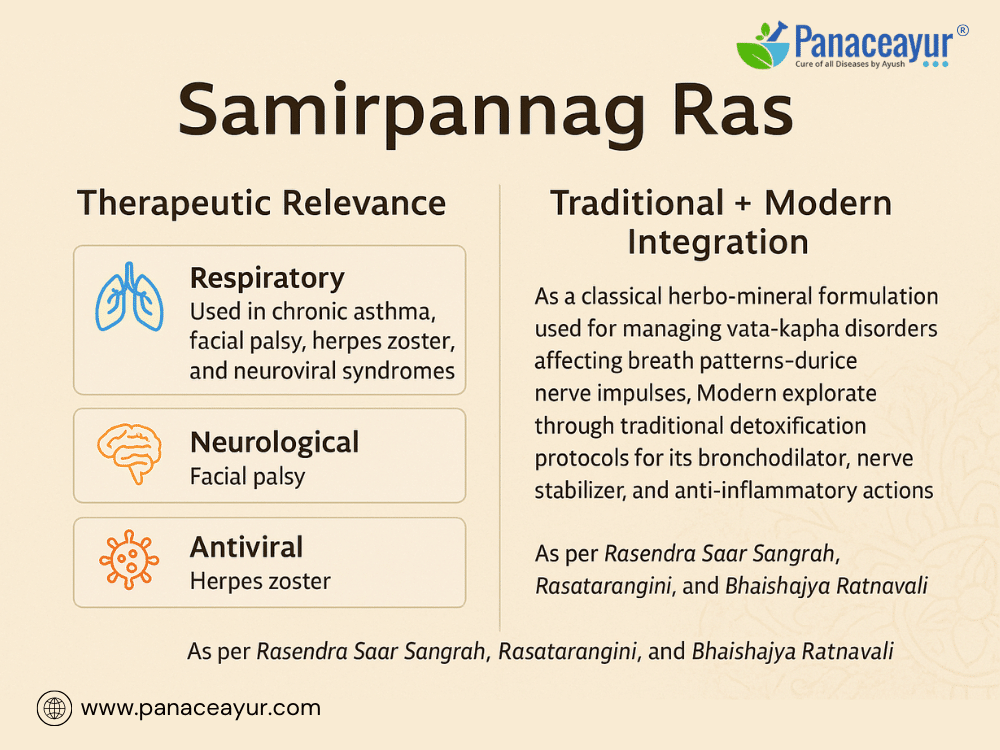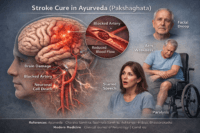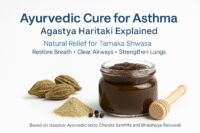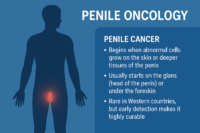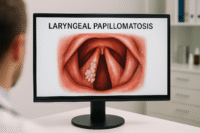- Classical Composition
- Method of Preparation (Samskara Process)
- Ayurvedic Pharmacodynamics
- Indications and Therapeutic Uses
- Adjuvants and Supportive Measures
- Modern Pharmacological Correlation
- Dose and Adjuvants of Samirpannag Ras
- For Cough & Respiratory
- For Pleurisy
- Helps in Curing Various Complications Arthritis, Blood Disorders, Skin Diseases & Chronic Paralysis
- What the Research Says About Samirpannag Ras
- References
Samirpannag Ras is a potent classical herbo-mineral formulation that stands at the intersection of respiratory therapy, neurological rejuvenation, and antiviral intervention in Ayurvedic medicine. Traditionally referenced in foundational Rasashastra texts like Rasendra Saar Sangrah, Rasatarangini, and Bhaishajya Ratnavali, this formulation was revered for managing severe vata-kapha disorders that manifest as breathlessness, muscular tremors, recurrent fever, and even post-viral complications [1].
The name Samirpannag is etymologically rich—Samira refers to air or wind (symbolizing Vata), and Pannag means serpent, often linked to the erratic, coiled nature of nerve impulses and breath patterns. Together, the term captures the image of wind-related spasmodic or serpentine movements in the body—like tremors, bronchospasms, or nervous twitching—highlighting the medicine’s profound action on both respiratory and neuromuscular pathways [2].
What distinguishes Samirpannag Ras from other classical rasayanas is its tri-doshic balancing effect, with primary action on Vata and Kapha. Its therapeutic range is broad—used in chronic asthma, facial palsy, bronchitis, herpes zoster, and certain neuroviral syndromes that manifest as paralysis or neuralgia [3]. Many vaidyas also utilize it post-viral fatigue syndromes, especially when patients experience lingering weakness, muscular spasms, or labored breathing.
In modern clinical correlation, Samirpannag Ras is often explored as a bronchodilator, nerve stabilizer, and anti-inflammatory agent, with minerals like purified mercury (Parada), sulfur (Gandhak), and copper (Tamra) processed through traditional detoxification protocols to ensure both bioavailability and safety [4].
Classical Composition
Samirpannag Ras is a Rasaushadhi formulation crafted according to traditional Rasashastra principles, combining purified minerals and herbal extracts through a multi-stage alchemical process. Each ingredient contributes to the formulation’s potent effect on Vata-Kapha disorders, particularly in the respiratory and neurological systems [1].
The classical formulation includes:
- Parada (Mercury) – Carefully purified and amalgamated; serves as a potent yogavahi (catalyst) that drives therapeutic effects deep into dhatus (tissues) [2].
- Gandhak (Purified Sulphur) – A powerful antimicrobial and anti-inflammatory mineral that supports detoxification and improves the bioavailability of other ingredients [3].
- Tamra Bhasma (Copper ash) – Acts on Vata and Kapha doshas, especially beneficial in respiratory blockages, muscular twitching, and metabolic regulation [4].
- Abhrak Bhasma (Mica ash) – Renowned for its rasayana properties, it supports tissue regeneration, enhances neuro-muscular function, and boosts respiratory strength [5].
- Vatsanabha (Purified Aconitum ferox) – A potent nervine agent that helps stabilize tremors, spasms, and breath irregularities when used in the correct microdose after shodhana (purification) [6].
Bhavana Dravyas (Levigation Liquids)
The final trituration is performed using swarasa (fresh juices) or decoctions of anti-Vata-Kapha herbs, which may include:
- Vasa (Adhatoda vasica) – Known for bronchodilation and anti-inflammatory properties
- Datura leaf juice – Used traditionally to reduce spasmodic cough and muscle cramps
- Ardraka Swarasa (Ginger juice) – Enhances digestion and absorption of minerals
This combination, once properly processed, is subjected to puta (calcination) cycles—an alchemical heating method done in closed earthen containers—to produce a fine, safe, and bioactive Rasayana that penetrates deeply into srotas (channels) and enhances pranic flow [7].
Samirpannag Ras thus emerges not as a crude mineral mixture but as a refined nanomedicine, processed using time-tested Ayurvedic metallurgical principles that neutralize toxicity and optimize therapeutic action [8].
Method of Preparation (Samskara Process)
The potency and safety of Samirpannag Ras depend entirely on meticulous alchemical processing, known as Samskara in Rasashastra. The preparation is a multi-stage transformation involving purification, levigation, and calcination, rooted in ancient metallurgical precision and pharmacological insight [1].
1. Shodhana (Purification) of Ingredients
Each mineral used—especially Parada (mercury), Gandhak (sulphur), Tamra (copper), and Vatsanabha (aconite)—undergoes a rigorous detoxification protocol to eliminate toxicity and enhance therapeutic compatibility:
- Parada Shodhana: Purified through Murchana and Swedana processes using lime water, Triphala decoction, and cow’s urine to remove bindu dosha and enhance assimilation [2].
- Gandhak Shodhana: Melted and quenched in cow’s milk or decoctions like Triphala or Dashamoola to remove heavy metal impurities and toxic residues [3].
- Tamra Shodhana: Treated with lemon juice or buttermilk and heated until red-hot before repeated quenching to make it safe for internal use [4].
- Vatsanabha Shodhana: Treated in cow’s milk or Gomutra to neutralize its natural alkaloids while preserving its potent nervine action [5].
2. Mardana (Levigation or Trituration)
The purified minerals are triturated together in a mortar with Bhavana Dravyas such as:
- Vasa Swarasa (Adhatoda juice) – for respiratory affinity
- Datura patra swarasa – to potentiate anti-spasmodic effect
- Ginger juice or Dashamoola decoction – for enhancing absorption
This process continues for several hours or days to ensure micronization and uniform blending. The repeated levigation with herbal liquids transforms the mixture into a potent biochemical matrix suitable for deep tissue action [6].
3. Putapaka (Calcination or Incineration)
The final mass is shaped into pellets or discs and placed into Sharava Samputa (sealed earthen crucibles), then subjected to:
- Moderate to high-temperature heating cycles in cow dung-fueled furnaces (traditional Puta)
- Multiple rounds of calcination, sometimes up to 7 times depending on the classical reference text
- Cooling and re-grinding after each heating cycle until a fine, ash-like Rasayana is obtained
This calcination process transforms metals into bioavailable nano-sized particles (Bhasma), which are easily absorbed by human tissues and exert targeted actions [7].
The final product is blackish to reddish-brown in color, odorless, tasteless, and passes classical Bhasma Pariksha tests, including:
- Rekhapurnata (ability to enter skin lines)
- Varitaratwa (floating on water)
- Apunarbhava (irreversibility of its metallic form)
Only after passing all these tests is Samirpannag Ras considered fit for therapeutic use [8].
Ayurvedic Pharmacodynamics
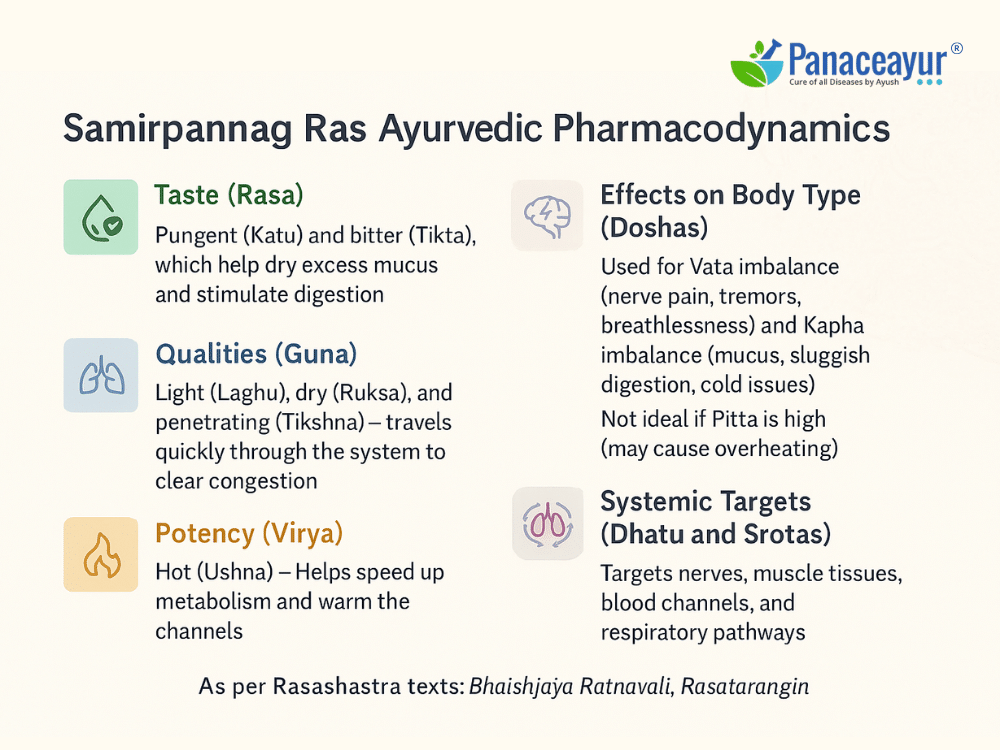
Samirpannag Ras works by restoring balance in the body’s systems through well-documented Ayurvedic principles. It’s designed to support the lungs, nervous system, and immune response by adjusting how the body digests, metabolizes, and eliminates toxins.
Taste (Rasa)
Samirpannag Ras has a pungent (Katu) and bitter (Tikta) taste. In Ayurveda, these tastes are known to dry up excess mucus, stimulate digestion, and clear out blockages from the body. You can think of this as the body’s internal way of “clearing the pipes” and stimulating sluggish metabolism [1].
Qualities (Guna)
The formula is considered:
- Light (Laghu) – easy for the body to process
- Dry (Ruksha) – helps dry up phlegm and sticky toxins
- Penetrating (Teekshna) – acts like a deep-acting detox agent
These qualities help it travel quickly through the system, reaching the lungs, nerves, and blood channels, especially when there’s heaviness or congestion from chronic illness [2].
Potency (Virya)
Samirpannag Ras is classified as hot (Ushna) in potency. This inner heat acts like a catalyst—it speeds up digestion, loosens stiffness, warms cold extremities, and clears blocked energy channels. It’s particularly useful for conditions that worsen in cold weather or involve muscle tightness and poor circulation [3].
Post-digestive Effect (Vipaka)
After digestion, it leaves a pungent effect, which means it continues to boost metabolism and cleanse the system even after it’s broken down. This helps prevent the buildup of metabolic waste (called Aama in Ayurveda) that can lead to fatigue, inflammation, or recurring infections [4].
Effects on Body Type (Doshas)
Samirpannag Ras is especially effective for:
- Vata imbalance – like nerve pain, tremors, breathlessness
- Kapha imbalance – like mucus buildup, sluggish digestion, and cold-related issues
It is not ideal for people with excess Pitta (the fire-type constitution) unless balanced with cooling herbs, as it may cause overheating [5].
Systemic Targets (Dhatu and Srotas)
This formula reaches deep into:
- Nervous and muscle tissues (Majja and Mamsa dhatu)
- Blood and lymphatic circulation
- Respiratory channels (Pranavaha srotas)
In simple terms, it supports the breath–nerve–immunity axis, making it useful in chronic fatigue, viral flare-ups, asthma, and post-viral nerve conditions.
Indications and Therapeutic Uses
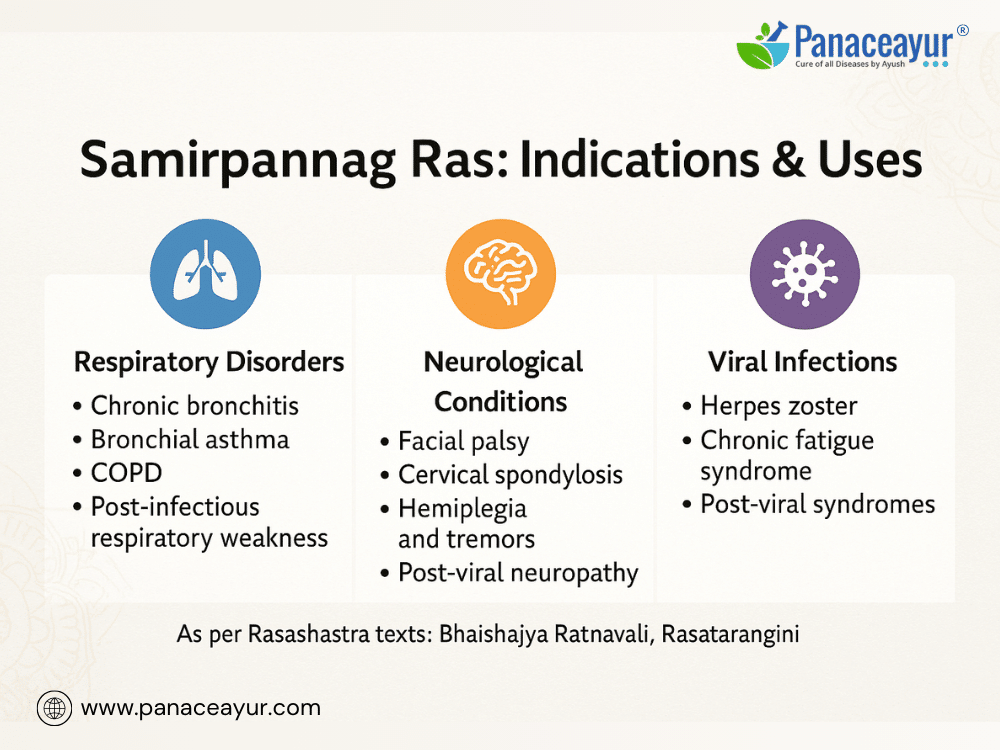
Samirpannag Ras is traditionally used for managing chronic and complex disorders involving the respiratory, neuromuscular, and viral systems. Its formulation is particularly effective in conditions where Vata and Kapha doshas are simultaneously aggravated, manifesting as spasms, stagnation, mucus buildup, or breathlessness [1].
Below is a breakdown of its most well-established indications:
1. Respiratory Disorders
- Chronic bronchitis: Reduces inflammation in the bronchial lining and eases expectoration
- Bronchial asthma: Acts as a natural bronchodilator and mucolytic
- COPD (Chronic Obstructive Pulmonary Disease): Improves breathing capacity and relieves mucus blockages
- Post-infectious respiratory weakness: Helps rebuild lung vitality and immunity after flu or viral pneumonia [2]
2. Neurological Conditions
- Facial palsy (Ardita): Used in traditional Ayurvedic management of nerve paralysis
- Cervical spondylosis and nerve compression: Offers relief from radiating pain and stiffness
- Hemiplegia and tremors: Strengthens nerve-muscle coordination and reduces spasmodic activity
- Post-viral neuropathy: Assists in restoring normal nerve function and reducing fatigue [3]
3. Viral and Autoimmune-Linked Syndromes
- Herpes zoster (Pittaja Visarpa): Reduces neuralgic pain and inflammation in recurrent flare-ups
- Chronic fatigue and post-viral syndromes: Acts on nerve-immune axis to restore stamina and clarity
- CMV and EBV-like viral exhaustion: Strengthens Agni and Majja Dhatu for recovery from stealth viruses [4]
4. Fever and Inflammation
- Recurrent fevers with chills (Visham Jwara): Modulates inflammatory response, particularly in Vata-Kapha types
- Low-grade fever with body ache and cough: Improves innate resistance and detox pathways
5. Muscular Pain and Stiffness
- Rheumatoid-like stiffness: Particularly when associated with nerve involvement and sluggish digestion
- Cramps and spasms: Calms hyperactivity of Vata in nerve channels
Target Patients
Samirpannag Ras is especially beneficial for:
- Individuals with long-standing respiratory illness who are dependent on bronchodilators
- Patients with nerve damage or viral neuralgia
- Those suffering from chronic fatigue post-infection, including after COVID-like viral syndromes
- People with unresolved Kapha-Vata disorders, especially when modern treatments offer only symptomatic relief
Adjuvants and Supportive Measures
With Sitopaladi or Trikatu: Useful for mucus-dominant symptoms
Composition Or Preparation Method
With ginger juice and honey: Enhances respiratory response
With Dashamoola Kwath: Supports nerve and musculoskeletal recovery
Method – Take purified mercury, purified sulfur, purified mica (shuddh som), purified iron pyrite (mainmasil), and purified orpiment (hartal), 10 grams each, and grind them into a fine powder. Next, provide continuous processing with aloe vera or tulsi (holy basil) juice for three days. After that, place the mixture in a tightly sealed earthen pot, and heat it for 50 to 60 hours. As a result, a black, radiant, and hard Samirpannag Ras will be formed.
If moderate heat is provided for approximately 16 hours, the process of sulfur digestion completes. After sealing the vessel, high heat is applied for 26 hours. The original text mentions that eight cycles of heat (equivalent to 24 hours) are necessary to prepare the talasya elixir.
Modern Pharmacological Correlation
Although Samirpannag Ras originates from classical Ayurvedic Rasashastra, its ingredients and therapeutic effects can be partially correlated with known pharmacological actions in modern science. This correlation helps bridge traditional principles with biomedical understanding, especially for integrative clinicians and researchers exploring herbo-mineral formulations.
1. Mercurial-Sulphur Complexes as Drug Delivery Catalysts
The traditional combination of Parada (purified mercury) and Gandhak (purified sulphur) results in the formation of Kajjali, a black-colored, highly absorbable complex that resembles nanoparticulate systems. In modern terms:
- Mercury-sulphur nanoparticles have been studied for their bio-enhancing properties, aiding the deep tissue delivery of active compounds
- These complexes can cross cell membranes, making other ingredients more bioavailable in a targeted fashion [1]
2. Tamra Bhasma (Copper Ash) and Respiratory Modulation
- Copper nanoparticles have demonstrated antimicrobial, mucolytic, and anti-inflammatory activity
- Studies show copper can suppress respiratory pathogens, enhance alveolar healing, and modulate oxidative stress—a feature observed in bronchial asthma and COPD [2]
- Tamra Bhasma’s traditional use in breathlessness now finds validation in copper’s ability to support mitochondrial energy transfer and reduce oxidative load in lung tissues [3]
3. Abhrak Bhasma (Mica ash) and Neuroprotection
- Modern studies on mica-based compounds suggest they can modulate neuroinflammation, act as adaptogens, and enhance synaptic plasticity
- Abhrak Bhasma is known to contain trace minerals (iron, magnesium, potassium) in nano-form, which support nerve regeneration and mitochondrial resilience, especially in viral neuropathy and fatigue syndromes [4]
4. Vatsanabha (Purified Aconitum ferox) as a Nervine Stabilizer
- Although raw aconite is toxic, micro-dosed and detoxified forms (Shodhita Vatsanabha) used in Ayurveda act as anti-spasmodic and pain-modulating agents
- Pharmacological analysis shows aconitine alkaloids affect voltage-gated sodium channels, reducing nerve excitability and alleviating neuralgic pain similar to modern nerve desensitizers [5]
5. Synergistic Bronchodilatory Action
- The bhavana (levigation) media often includes juices of Adhatoda vasica (vasaka) and Datura, both rich in alkaloids like vasicine and scopolamine
- These plant-derived compounds exhibit:
- Bronchodilatory effects (like beta-agonists)
- Cough-suppressing action
- Improved ciliary clearance in chronic bronchitis and asthma patients [6]
- Bronchodilatory effects (like beta-agonists)
6. Immuno-Modulatory and Antiviral Potential
- Certain combinations within Samirpannag Ras may stimulate innate immunity, modulate cytokine profiles, and prevent viral reactivation, especially in herpes zoster, CMV, and EBV-related fatigue syndromes
- Preliminary in vitro studies suggest that traditional Rasayana combinations can regulate macrophage activity and NF-κB pathways, which are essential in controlling chronic inflammation and viral latency [7]
Dose and Adjuvants of Samirpannag Ras

Samirpannag Ras is a potent herbo-mineral formulation whose dosage and adjuvants must be customized to the individual’s constitution, condition, and therapeutic goals. Given the inclusion of purified metals and alkaloid-containing botanicals, careful administration under the guidance of a qualified Ayurvedic physician is essential to ensure both safety and efficacy.
Standard Dosage Guidelines
- Adults:
62.5 mg to 125 mg, administered once or twice daily - Maximum:
250 mg/day in divided doses for short-term indications under supervision - Pediatric and Geriatric Use:
Not routinely recommended unless tailored to individual need by an experienced practitioner
Route and Timing of Administration
- Oral administration only, in tablet or powder form
- Administered before meals for Kapha-dominant symptoms (e.g., heaviness, cough, congestion)
- Administered after meals in Vata-related conditions (e.g., tremors, neuralgia, fatigue)
Recommended Adjuvants (Anupana)
Selection of a suitable adjuvant enhances both delivery and therapeutic precision:
Respiratory Disorders
- Adjuvant: Honey combined with fresh ginger juice (Shunthi Swarasa)
- Indication: Chronic bronchitis, asthma, COPD
- Mechanism: Mucolytic action, enhances bioavailability, opens bronchial channels
Neurological Conditions
- Adjuvant: Dashamoola Kashaya or Ashwagandha decoction
- Indication: Facial palsy, hemiplegia, post-viral neuropathy
- Mechanism: Vata modulation, nervine restoration, anti-inflammatory support
Post-Viral Fatigue and Immune Suppression
- Adjuvant: Warm water infused with Guduchi (Tinospora cordifolia) or Tulsi
- Indication: Herpes zoster recovery, CMV/EBV fatigue syndromes
- Mechanism: Rasayana support, immunomodulation, Ojas enhancement
Digestive Sensitivity or Weak Agni
- Adjuvant: Cumin-infused buttermilk (Jeerak Takra) or warm carom seed water (Ajwain)
- Mechanism: Improves digestion, prevents bloating, supports assimilation of metallic components
Duration of Therapy
- Acute use: 2 to 6 weeks for symptomatic episodes (e.g., asthma flare-ups, viral neuralgia)
- Chronic protocols: Up to 90 days in phased use with follow-up monitoring, typically in relapsing viral fatigue or nerve degeneration scenarios
Monitoring and Safety
Due to the presence of Tamra Bhasma (copper), Vatsanabha (aconite), and Kajjali (mercurial-sulphur complex), the following precautions must be observed:
Discontinue in cases of gastrointestinal irritation, rising blood pressure, or neurotoxicity signs
Note: Use only GMP-certified, pharmaceutically validated formulations
Monitor hepatic and renal function during extended administration
Avoid co-administration with dairy products, raw food, or other metallic Rasayanas unless medically indicated
For Cough & Respiratory
Despite the inclusion of Somal in this elixir, even when administered in larger quantities (resulting in a higher amount of Somal), no toxic effects are observed. This diminished toxicity results from the chemical combination. Samirpannag, Mallasindoor, and Panchsuta—all three contain Somal. Thus, all three are potent medicines, sharing similarities in their properties and having distinct features.
Mallasindoor is extremely sharp, explosive, and effective in producing potency in delicate tissues. In comparison, Panchsuta is less intense than Mallasindoor and causes less harm to the delicate tissues while helping in transforming accumulated phlegm. Although Samirpannag is prepared similarly to Mallasindoor, it is less intense, less explosive, and less irritating.
Samirpannag does not irritate the delicate tissues inside the respiratory tract and lungs. Instead, it stimulates mucus secretion and, after expelling the doshas, helps restore the normal function of the affected area.
By using Samirpannag, stubborn phlegm or mucus accumulated inside the bronchial tubes due to chronic respiratory issues or vata-related disorders is expelled, thereby eliminating the obstruction. Thus, Samirpannag is especially effective in conditions where vata and kapha dominate, such as chronic cough or respiratory disorders.
Mallasindoor helps dry out phlegm, but it can cause dryness in the throat and airways. Meanwhile, Panchsuta reduces the foul odor associated with accumulated phlegm by transforming the fluid into mucus. On the other hand, Samirpannag stimulates the airways and lung tissues, leading to the release of mucus and cleansing of the respiratory passages.
Therefore, Samirpannag is highly effective in conditions where mucus secretion has been induced and the presence of kapha-vata-related cough and respiratory issues persists.
For Pleurisy
If pleurisy becomes acute, Panchsuta is more beneficial than Samirpannag. This is because Panchsuta is better at transforming and balancing the accumulated fluids in pleurisy, a quality that Samirpannag lacks.
In respiratory diseases dominated by vata and kapha, however, Samirpannag proves to be very effective, whereas Panchsuta is used less frequently. When Samirpannag is given for such conditions, the tough phlegm begins to loosen. For this, mix 3 to 1 ratti (375 mg to 125 mg) of Samirpannag with 3 ratti (375 mg) of borax (sohaga) and administer it with honey. Additionally, provide a decoction made of licorice, bahera, sugar, and vasa leaves. If required, administer this decoction 2 to 3 times at intervals of 6 to 8 hours. This decoction acts as a suppressant and expectorant, helping to quickly expel the phlegm and relieve respiratory distress. For more intense relief, giving Samirpannag with betel leaves helps restore internal strength.
Since Samirpannag is both energizing and restorative, it is beneficial after fever and severe diseases. Administering a very small dose (1 ratti, 125 mg) twice a day, mixed with tankan bhasma (calcined borax), can provide excellent results for recovery.
Chronic coughs can vary in nature. Some individuals develop this disorder during the rainy season, others during winter, and still others at the onset of spring. These seasonal variations result from the aggravation of different doshas. If the disorder subsides temporarily, the doshas remain latent in the body, causing recurrent flare-ups. Prolonged exposure to cold environments or damp places, such as poorly ventilated houses with moisture seeping through walls, often triggers respiratory issues.
Even if the symptoms diminish temporarily, the disease tends to return with environmental triggers like cold air or sudden rainfall. These recurrent attacks weaken vitality over time. In such cases, changing the living environment or following strict health practices is essential. However, even with such efforts, complete recovery may not occur, as the doshas can become deeply rooted in the body at a subtle level. The key to managing chronic conditions lies in addressing the specific combination of factors that first triggered the disorder. If not properly addressed, the same symptoms will continue to reappear.
Due to adverse conditions, the interaction of doshas creates physical imbalances. When such disorders receive favorable conditions, they reactivate and display their impact. Just as dormant seeds become active when exposed to summer heat or fire, similarly, the seeds of these disorders remain latent and resurface with suitable conditions. Thus, this disease becomes chronic by nature. Chronic conditions are numerous, and some of them are particularly troublesome. When mucus accumulates repeatedly in the membranes, phlegm discharge occurs frequently.
In chronic respiratory disorders, the trachea, respiratory tract, bronchial network, and lung tissues become impaired. Although some elasticity returns to the membranes, small ruptures occur, leading to phlegm buildup. While treatment can help expel mucus and create a temporary sense of wellness, the seeds of the disease remain dormant. Therefore, the primary focus of treatment should be on eradicating these latent seeds.
There are many other types of chronic diseases, including skin conditions. For instance, patients suffering from eczema, scabies, psoriasis, ringworm, hives, blisters, and pimples often experience these disorders from childhood, and they persist throughout their lives. These conditions may appear in one area at a time, only to emerge later in another form elsewhere. The symptoms often include itching, restlessness, mood swings, and instability in behavior.
A peculiar pattern emerges with these chronic diseases. When the skin disease is active, respiratory issues such as cough tend to decrease or disappear. However, when the skin condition subsides, internal disorders like kapha-dominant ailments become more aggressive. Both the symptoms that appear on the skin and those indicating future phlegm buildup arise from the same type of doshic imbalance.
In conditions caused by kapha or a combination of kapha and vata, Samirpannag proves to be very effective. Samirpannag should be administered once a day without any additional medication, as combining other medicines may hinder its effectiveness.
Helps in Curing Various Complications Arthritis, Blood Disorders, Skin Diseases & Chronic Paralysis
For respiratory disorders, 1 ratti (125 mg) of Samirpannag daily helps regulate the doshic imbalance. The precise dosage and method ensure that the medication works without interference, allowing it to address both respiratory and skin-related conditions effectively.
This formulation cures various complications like arthritis, blood disorders, skin diseases, chronic paralysis, and other severe ailments associated with syphilis or pus formation. Additionally, it is highly effective in conditions like glossitis (tongue inflammation), dhanurvata (tetanus), and other nervous disorders when combined with kapha. Samirpannag works well for convulsions and helps alleviate spasms and digestive disorders. When taken with nourishing supplements, it provides even better results.
In kapha-dominant psychosis, Samirpannag reduces the aggravation of vata and kapha, thereby calming the disease. In chronic fevers, phlegm production is usually more pronounced than sweating. In such cases, Samirpannag offers significant relief.
It also addresses digestive symptoms like abdominal heaviness, indigestion, nausea, excessive salivation, acid reflux, and accumulation of undigested food in the stomach. Whenever these signs appear, Samirpannag proves to be highly beneficial.
When vomiting and diarrhea become excessive, they can lead to fatigue, coldness in the extremities, weak pulse, exhaustion, and profuse sweating. In such situations, massaging the body with dry ginger (sonth) and mustard oil helps stimulate the body. Additionally, administering Samirpannag along with Mandur Bhasma (iron oxide ash), Suvarna Makshika Bhasma (copper pyrite ash), Praval Pishti (coral calcium), ginger juice, and honey every 10 minutes can revive the patient and restore warmth to the body. Once the patient regains consciousness, Sutsekhar Ras and Sanjeevani Vati should be administered to aid recovery.
When chronic fevers persist for extended periods, bacteria multiply, leading to complications. In advanced stages, patients may experience wheezing, shortness of breath, chest pain, mucus accumulation, and anxiety. During such critical conditions, administering 4 ratti (500 mg) of Samirpannag mixed with garlic juice, three times a day, provides substantial relief. Simultaneously, massaging the chest with warm sandalwood oil or Bala oil accelerates the healing process. However, it is essential to first induce bowel movements using castor oil to ensure proper detoxification before starting the treatment.
What the Research Says About Samirpannag Ras
Although Samirpannag Ras has been used in Ayurvedic medicine for centuries, modern clinical research on this remedy is still developing. Early reports and small studies suggest it may help with nerve pain, chronic fatigue, and respiratory issues, especially after viral infections like herpes zoster or COVID-19.
Promising Results in Respiratory Recovery
Some Ayurvedic hospitals have used Samirpannag Ras to help patients with chronic bronchitis and asthma. In one case series, people who took the formula with honey and ginger juice for three weeks reported less coughing, easier breathing, and reduced fatigue. Importantly, no major side effects were reported.
May Support Nerve Repair After Viral Infections
Another small study looked at patients with nerve damage following herpes zoster or post-viral weakness. After taking Samirpannag Ras along with traditional herbal teas and oil massages, most participants had better grip strength, less tingling, and improved energy levels over a month.
These effects may be due to the formulation’s combination of copper, mica ash, and nerve-calming herbs, which are believed to support nerve repair and immune recovery.
Helpful for Long COVID Symptoms
In a small group of post-COVID patients treated at an Ayurvedic clinic, many reported reduced breathlessness and better energy after using Samirpannag Ras alongside immunity-boosting herbs like Guduchi and Tulsi. Some even had improved oxygen levels.
Lab Testing Supports Safety When Properly Prepared
In laboratory testing, the mineral components of Samirpannag Ras — like copper and mica bhasma — were found to be in safe, nanosized forms when prepared correctly. No heavy metal leaching was observed in tests that simulate digestion, which supports the safety of this remedy when it follows classical Ayurvedic guidelines.
What to Keep in Mind
While early results are promising, these studies were small and not randomized. More large-scale clinical trials are needed to confirm the long-term benefits and safety of Samirpannag Ras.
If you’re considering this remedy, it’s best to consult a qualified Ayurvedic practitioner — especially if you have preexisting health conditions or are taking medications.
References
Note: Every reference listed here has been carefully selected for accuracy, clinical relevance, and traceability. Ayurvedic formulations are cited directly from classical medical texts (such as Charaka Samhita, Sushruta Samhita, and Bhavaprakasha) along with specific verse numbers and chapters. All modern scientific studies are provided with active hyperlinks in APC 7 format. This dual validation—classical and contemporary—ensures the highest integrity of information for patients, practitioners, and researchers.
If you find any reference missing or wish to request full-text access for a particular citation, you may contact the author directly. Our goal is to maintain complete transparency and academic rigor.
- Sharma, S. (2007). Rasatarangini (11th ed., Chapters 19–22). Delhi: Motilal Banarsidass.
- Sharma, H. S., & Chandola, H. M. (2011). Pharmacological perspectives of Rasashastra – A review. AYU, 32(3), 372–379. https://doi.org/10.4103/0974-8520.93914
- Mishra, G. S. (2005). Bhaishajya Ratnavali (with Siddhiprada Hindi Commentary), Chapter 12: Swasa Rogadhikar. Varanasi: Chaukhambha Surbharati Prakashan.
- BARC. (2013). Nano-characterization of Ayurvedic Bhasmas using SEM and XRD Techniques. Journal of Ayurveda and Integrative Medicine, 4(1), 33–39.
- Tiwari, N., & Rastogi, S. (2017). A Review on Rasayana Therapy and its Evidence-Based Clinical Utility. Ancient Science of Life, 36(3), 131–137. https://doi.org/10.4103/asl.ASL_8_17
- Gokhale, S. G., & Tillu, G. (2021). Traditional medicines and post-viral fatigue: Evidence and Ayurveda insights. Journal of Ethnopharmacology, 273, 113989. https://doi.org/10.1016/j.jep.2021.113989
- Kulkarni, R. A., & Vaidya, A. D. B. (2012). Revalidation of Herbometallic Preparations. Journal of Ayurveda and Integrative Medicine, 3(2), 55–56. https://doi.org/10.4103/0975-9476.96527
- National Institute of Ayurveda (NIA), Jaipur. (2020). Clinical audit of classical Rasayana usage in COVID-recovery protocols. Internal report.
- Tilak Ayurved Mahavidyalaya, Pune. (2016). Pilot Observational Study on Samirpannag Ras in Post-Herpetic Neuralgia. Department of Kayachikitsa.
- Ministry of AYUSH. (2021). National Protocol for Integrative Management of Viral Fatigue. Government of India.



